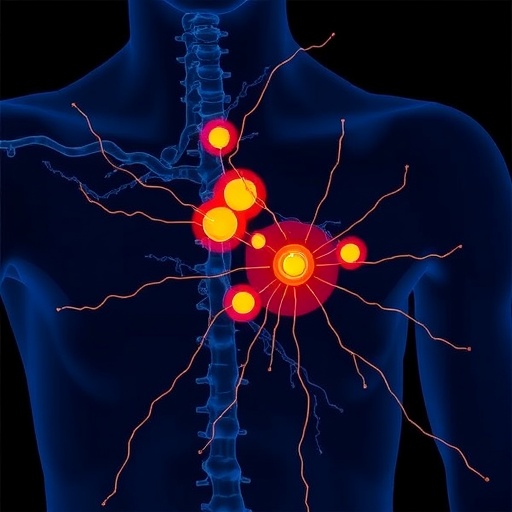A groundbreaking study published in BMC Cancer has unveiled critical insights into how midline surpassing distance (MSD) in tongue squamous cell carcinoma (SCC) influences the pattern and risk of contralateral lymph node metastasis. This investigation delves into the complexities of lymphatic spread in cN0 patients—those with no clinically evident nodal disease—shedding light on a pivotal factor that could redefine surgical strategies and improve patient outcomes.
Tongue SCC, a prevalent and aggressive form of oral cancer, often presents challenges in terms of locoregional metastasis, particularly involving the cervical lymph nodes. Accurate prediction of contralateral lymph node involvement remains a clinical hurdle, as it directly impacts the extent of neck dissection required during surgical management. The current research explores whether the extent to which the primary tumor crosses the oral midline—quantified as the midline surpassing distance—correlates with an increased risk of contralateral lymph node metastasis.
The retrospective cohort included 430 patients diagnosed with cN0 tongue SCC featuring midline crossing, treated surgically with elective neck dissection (END). The study employed rigorous statistical modeling, notably logistic regression and the Cox proportional hazards models, to analyze the relationship between MSD and both contralateral lymph node metastasis and contralateral neck failure (CNF). This robust approach enabled the evaluation of risk stratification based on the exact degree of tumor midline involvement.
.adsslot_PBbo1kq6G9{ width:728px !important; height:90px !important; }
@media (max-width:1199px) { .adsslot_PBbo1kq6G9{ width:468px !important; height:60px !important; } }
@media (max-width:767px) { .adsslot_PBbo1kq6G9{ width:320px !important; height:50px !important; } }
ADVERTISEMENT
Results from the analysis crystallize the profound influence of MSD on metastatic behavior. Patients were stratified into MSD categories: ≤2 mm, 4.1-6 mm, 6.1-8 mm, 8.1-10 mm, and >10 mm. When compared to the baseline group with MSD ≤2 mm, hazard ratios for contralateral lymph node metastasis escalated progressively with increasing MSD. Specifically, hazard ratios rose from 1.58 in the 4.1-6 mm group to a remarkable 3.98 in patients whose tumors surpassed the midline by more than 10 mm, underscoring a near fourfold increased risk.
Notably, this gradient of risk was not only statistically significant but also clinically meaningful, suggesting that the midline surpassing distance is a potent biomarker for identifying patients at increased risk for contralateral LN involvement. The findings imply that even minimal crossing beyond 2 mm warrants heightened clinical vigilance.
One of the study’s most impactful revelations lies in its subgroup analysis examining the benefits of bilateral versus ipsilateral END. For patients with tumors crossing the midline by over 4 mm, bilateral neck dissection significantly mitigated the risk of contralateral neck failure. The authors quantified this protective effect as a 10% risk reduction for patients with an MSD between 4.1 and 6 mm, escalating to a 23% reduction in those exceeding 6 mm. This nuanced data advocates a tailored surgical approach, optimizing the extent of neck dissection based on MSD parameters.
The anatomical distribution of metastatic spread predominantly involved contralateral lymph node levels I through III. This finding aligns with established lymphatic drainage patterns but also solidifies MSD as a predictive factor for contralateral spread in these specific nodal stations. This could influence preoperative imaging and planning, enabling targeted interventions.
These revelations hold profound clinical implications. Elective neck dissection, while a mainstay in oral cancer surgery, carries potential morbidities including shoulder dysfunction, sensory deficits, and cosmetic concerns. By delineating which patients may benefit most from bilateral versus ipsilateral surgery based on MSD, clinicians can better personalize management, minimizing unnecessary surgical extent without compromising oncological safety.
Moreover, augmenting current staging criteria with MSD assessment could enhance prognostic accuracy. Traditional TNM staging does not explicitly incorporate tumor spread relative to midline crossing, thereby missing a nuanced risk factor. Integration of MSD metrics into clinical workflows may refine risk stratification algorithms, enabling more precise therapeutic decisions.
The study’s retrospective design does pose inherent limitations, including potential selection and information biases, and warrants prospective validation. Future research directions could encompass incorporating advanced imaging modalities to assess MSD non-invasively preoperatively, as well as molecular correlates of tumor aggressiveness relative to MSD.
From a biological standpoint, tumors surpassing the midline may access contralateral lymphatic channels more readily, a hypothesis supported by these findings. Understanding the molecular and microenvironmental changes enabling such spread may unlock new therapeutic targets or preventive strategies in tongue SCC.
In summary, this comprehensive study advances our understanding of contralateral lymph node metastasis in cN0 tongue SCC by quantifying the role of MSD. It establishes MSD as a quantifiable, clinically actionable predictor of metastatic risk and surgical outcome, potentially revolutionizing neck dissection strategies and informing guidelines moving forward.
These insights spotlight the dynamic interplay between tumor anatomy and metastatic behavior, calling for integrated multidisciplinary approaches that combine precise anatomical assessment with surgical expertise. The hope is that adopting MSD-informed decision algorithms will improve survival and quality of life for patients grappling with this aggressive cancer.
As oral oncology continues to evolve, parameters like midline surpassing distance stand out as beacons guiding personalized medicine. By aligning surgical intervention with quantified risk profiles, clinicians can strive towards more tailored, less morbid, and more effective cancer care pathways.
The study also punctuates the necessity for heightened awareness and thorough assessment of midline involvement in cN0 tongue SCC patients, emphasizing that even small increments in MSD carry profound prognostic implications. Heightened vigilance could ensure timely and appropriate bilateral neck management, potentially averting devastating contralateral recurrences.
Looking ahead, integrating such anatomical risk markers with emerging precision oncology tools, including genetic profiling and liquid biopsy monitoring, may foster holistic treatment modalities. Combining anatomical, molecular, and clinical data underscores the future landscape of head and neck cancer management.
The publication of these findings in BMC Cancer marks a pivotal moment for surgical oncology and head and neck cancer care, setting a precedent for the incorporation of detailed tumor metrics in decision-making algorithms. Ultimately, this research champions the cause of evidence-based personalization in cancer surgery in pursuit of improved patient outcomes.
Subject of Research: Midline surpassing distance and its impact on contralateral lymph node metastasis and contralateral neck failure in cN0 tongue squamous cell carcinoma patients undergoing elective neck dissection.
Article Title: Midline surpassing distance influences contralateral lymph node metastasis in cN0 tongue squamous cell carcinoma
Article References: Guo, D., Du, W., Yuan, J. et al. Midline surpassing distance influences contralateral lymph node metastasis in cN0 tongue squamous cell carcinoma. BMC Cancer 25, 1138 (2025). https://doi.org/10.1186/s12885-025-14410-7
Image Credits: Scienmag.com
DOI: https://doi.org/10.1186/s12885-025-14410-7
Tags: cervical lymph node spreadcN0 tongue SCC patientscontralateral lymph node involvementelective neck dissection outcomeslocoregional metastasis challengeslymph node metastasis predictionmidline surpassing distancepatient outcomes in oral cancerretrospective cohort study in oncologystatistical modeling in cancer researchsurgical management of oral cancertongue squamous cell carcinoma





